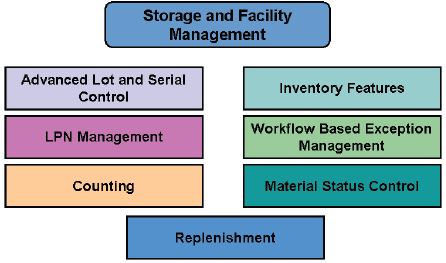
LPN Management: Warehouse Management enables operators to track the contents of any container in receiving, WIP, inventory, shipping, and in-transit.
In Oracle Warehouse Management, a license plate number (LPN) is any object that holds items. Although LPNs are associated with containers, they do not need to represent a physical entity, such as a box. Thus, you can define an LPN as a collection of items. Oracle Warehouse Management enables you to track, transact, and nest LPNs.
Advanced Lot and Serial Control: Warehouse Management enables operators to split, merge, and rename lots.
Material Status Control: Material status control enables operators to control the eligibility of material for various transactions.
Material Status control restricts the movement and usage of portions of on-hand inventory. Using material status control enables you to control whether you can pick or ship an internal order or sales order, or issue material for a work order. You can also specify whether material needs to be quarantined until you inspect it. In addition, you
can determine whether products with a particular status can be reserved, included in available to promise calculations, or netted in production planning. You assign material statuses at four levels: subinventory, locator, lot, and serial.
Inventory Features: Warehouse Management facilitates the movement of goods in to, out of, and within the warehouse.
Counting: operators can perform cycle counts and physical inventory counts.
Replenishment: Warehouse Management enables managers to manage inventory levels using any combination of planning and replenishment features, including: min-max planning, reorder point planning, or kanban replenishment. You can use Inventory and MRP replenishment planning, dynamic replenishment, and replenishment direct from receiving.
Kanban Management: Warehouse Management supports both internal and external supplier kanbans. Kanban is a means of supporting pull–based replenishment in manufacturing systems.
Workflow Based Exception Management: You can configure real-time alerts and workflow based notifications of supply chain events to improve the efficiency of business operations. For example, when an operator picks less than the required amount for an order, workflow sends a notification to the operator to count the locator.

1 comments
Thank you for sharing this post. I found it very informative and helpful. I run a warehouse for a shipping and production company. When I first started out processes were out of date and ineffective. We then started using warehouse management system consultants and it improved our day to day operations.
ReplyDelete